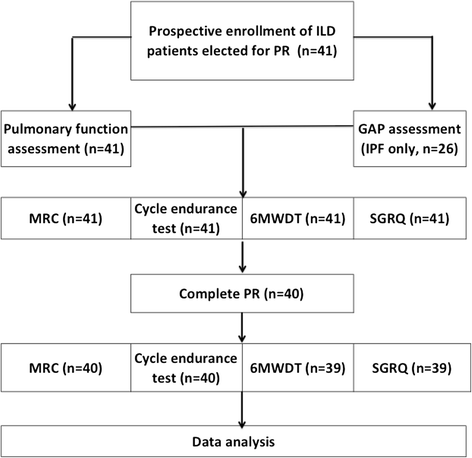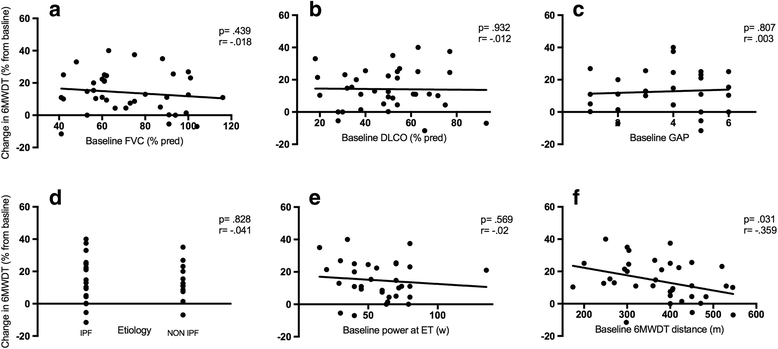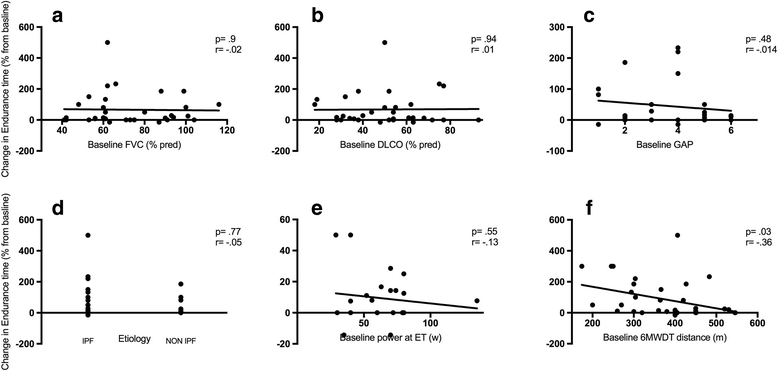Effectiveness of pulmonary rehabilitation in patients with interstitial lung disease of different etiology: a multicenter prospective study
- PMID: 29017478
- PMCID: PMC5633868
- DOI: 10.1186/s12890-017-0476-5
Effectiveness of pulmonary rehabilitation in patients with interstitial lung disease of different etiology: a multicenter prospective study
Abstract
Background: Recent evidences show that Pulmonary Rehabilitation (PR) is effective in patients with Interstitial Lung Disease (ILD). It is still unclear whether disease severity and/or etiology might impact on the reported benefits. We designed this prospective study 1) to confirm the efficacy of rehabilitation in a population of patients with ILDs and 2) to investigate whether baseline exercise capacity, disease severity or ILD etiology might affect outcomes.
Methods: Forty-one patients (IPF 63%, age 66.9 ± 11 ys) were enrolled in a standard PR course in two centers. Lung function, incremental and endurance cyclo-ergometry, Six Minutes Walking Distance (6MWD), chronic dyspnea (Medical Research Council scale-MRC) and quality of life (St. George Respiratory Questionnaire-SGRQ) were recorded before and at the end of PR to measure any pre-to-post change. Correlation coefficients between the baseline level of Diffuse Lung Capacity for Carbon monoxide (DLCO), Forced Vital Capacity (FVC), 6MWD, power developed during incremental endurance test, GAP index (in IPF patients only) and etiology (IPF or non-IPF) with the functional improvement at the 6MWDT (meters), at the incremental and endurance cyclo-ergometry (endurance time) and the HRQoL were assessed.
Results: Out of the 41 patients, 97% (n = 40) completed the PR course. Exercise performance (both at peak load and submaximal effort), symptoms (iso-time dyspnea and leg fatigue), SGRQ and MRC significantly improved after PR (p < .001). Patients with lower baseline 6MWD showed greater improvement in 6MWD (Spearman r score = - .359, p = .034) and symptoms relief at SGRQ (r = -.315, p = .025) regardless of underlying disease.
Conclusion: Present study confirms that comprehensive rehabilitation is feasible and effective in patients with ILD of different severity and etiology. The baseline submaximal exercise capacity inversely correlates with both functional and symptom gains in this heterogeneous population.
Keywords: Endurance test; Endurance time; Functional performance; Interstitial lung diseases; Pulmonary rehabilitation.
Conflict of interest statement
Ethics approval and consent to participate
The study was approved by the local review board and the Ethics Committee at both Institutions (Ethics Committee of Modena, University Hospital of Modena, via del Pozzo 71, 41,124 Modena, Italy and Ethics Committee of Florence, IRCSS don Gnocchi, Via di Scandicci, 269, 50,143 Firenze, Italy ref. number 64/14). All the individuals gave their written informed consent to participate.
Consent for publication
Not applicable.
Competing interests
The authors declare that they have no competing interests.
Publisher’s Note
Springer Nature remains neutral with regard to jurisdictional claims in published maps and institutional affiliations.
Figures





Similar articles
-
The evidence of benefits of exercise training in interstitial lung disease: a randomised controlled trial.Thorax. 2017 Jul;72(7):610-619. doi: 10.1136/thoraxjnl-2016-208638. Epub 2017 Feb 17. Thorax. 2017. PMID: 28213592 Clinical Trial.
-
Does the severity of interstitial lung disease affect the gains from pulmonary rehabilitation?Clin Respir J. 2018 Jun;12(6):2141-2150. doi: 10.1111/crj.12785. Epub 2018 Mar 24. Clin Respir J. 2018. PMID: 29498799
-
Predictors of benefit following pulmonary rehabilitation for interstitial lung disease.Respir Med. 2012 Mar;106(3):429-35. doi: 10.1016/j.rmed.2011.11.014. Epub 2011 Dec 17. Respir Med. 2012. PMID: 22182340
-
Characteristics of pulmonary rehabilitation programs and their effects on exercise capacity and health related quality of life (HRQoL) in patients with interstitial lung disease: A systematic review and meta-analysis.Respir Med. 2025 Feb;237:107936. doi: 10.1016/j.rmed.2024.107936. Epub 2025 Jan 4. Respir Med. 2025. PMID: 39756486
-
The Short- and Long-Term Impact of Pulmonary Rehabilitation in Subjects with Sarcoidosis: A Prospective Study and Review of the Literature.Respiration. 2021;100(5):423-431. doi: 10.1159/000514917. Epub 2021 Mar 30. Respiration. 2021. PMID: 33784708 Review.
Cited by
-
Cardiopulmonary exercise testing in interstitial lung diseases and the value of ventilatory efficiency.Eur Respir Rev. 2021 Nov 30;30(162):200355. doi: 10.1183/16000617.0355-2020. Print 2021 Dec 31. Eur Respir Rev. 2021. PMID: 34853093 Free PMC article. Review.
-
Respiratory rehabilitation in patients recovering from severe acute respiratory syndrome: A systematic review and meta-analysis.Heart Lung. 2022 May-Jun;53:11-24. doi: 10.1016/j.hrtlng.2022.01.005. Epub 2022 Jan 14. Heart Lung. 2022. PMID: 35108624 Free PMC article.
-
Cardiopulmonary Exercise Testing in Patients With Interstitial Lung Disease.Front Physiol. 2020 Jul 10;11:832. doi: 10.3389/fphys.2020.00832. eCollection 2020. Front Physiol. 2020. PMID: 32754054 Free PMC article. Review.
-
Utility of the six-minute walk test in patients with idiopathic pulmonary fibrosis.Multidiscip Respir Med. 2018 Dec 13;13:45. doi: 10.1186/s40248-018-0158-z. eCollection 2018. Multidiscip Respir Med. 2018. PMID: 30559965 Free PMC article. Review.
-
Comparison of high-intensity interval training versus moderate-intensity continuous training in pulmonary rehabilitation for interstitial lung disease: a randomised controlled pilot feasibility trial.BMJ Open. 2023 Aug 22;13(8):e066609. doi: 10.1136/bmjopen-2022-066609. BMJ Open. 2023. PMID: 37607782 Free PMC article. Clinical Trial.
References
-
- From the global strategy for the diagnosis, management and prevention of COPD . Global initiative for chronic obstructive lung disease (GOLD) 2017. - PubMed
Publication types
MeSH terms
LinkOut - more resources
Full Text Sources
Other Literature Sources
Medical
Research Materials
Miscellaneous

